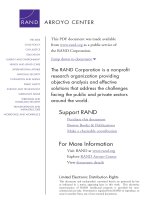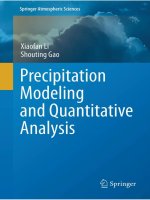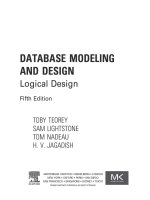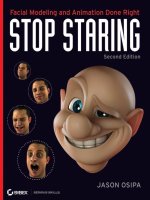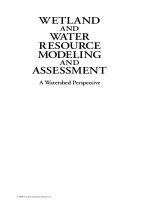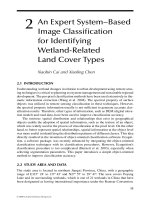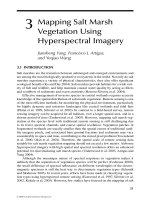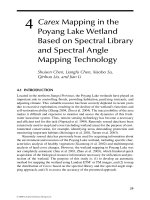Human muscle modeling and parameters identification
Bạn đang xem bản rút gọn của tài liệu. Xem và tải ngay bản đầy đủ của tài liệu tại đây (2.64 MB, 101 trang )
HUMAN MUSCLE MODELING AND
PARAMETERS IDENTIFICATION
ZHANG YING
(B.Eng. WHUT)
A THESIS SUBMITTED
FOR THE DEGREE OF MASTER OF ENGINEERING
DEPARTMENT OF ELECTRICAL & COMPUTER ENGINEERING
NATIONAL UNIVERSITY OF SINGAPORE
2009
Human Muscle Modeling and Parameters Identification
Acknowledgements
I would like to express my sincere appreciation to my supervisor Prof. Xu Jian-Xin
for his supervision, excellent guidance, support and encouragement throughout my
research progress.
His erudite knowledge, the deepest insights on the fields of learning control and
optimization have been the most inspirations and made this research work a rewarding
experience. Also, his rigorous scientific approach and endless enthusiasm have
influenced me greatly. Without his kindest help, this thesis would have been
impossible.
Thanks also go to Electrical & Computer Engineering Department in National
University of Singapore, for the opportunity of my pursuit of study in Singapore.
I sincerely acknowledge all the help from my senior Dr. Huang Deqing and friends in
Control and Simulation lab, the National University of Singapore. Their kind
assistance and friendship not only give huge help to my research but have made my
life easy and colorful in Singapore.
Last but not least, I would thank my family members for their support, understanding,
patience and love to me. This thesis is dedicated to them for their infinite stability
margin.
i
Human Muscle Modeling and Parameters Identification
Table of Contents
Acknowledgements ............................................................................................................................. i
Table of Contents................................................................................................................................ ii
Summary ........................................................................................................................................... iv
List of Tables ..................................................................................................................................... vi
List of Figures .................................................................................................................................. vii
Chapter 1
Introduction .................................................................................................................... 1
1.1
Background .................................................................................................................... 1
1.2
Significance .................................................................................................................... 3
1.3
Outline of Thesis ............................................................................................................ 5
Chapter 2
2.1
Understanding of human musculoskeletal structure ....................................................... 7
Interior structure of skeletal muscle ............................................................................... 7
2.1.1
Structural organization of the muscle ............................................................................. 7
2.1.2
Muscle fibre type and motor unit ................................................................................... 8
2.2
Architecture of the muscle and joint............................................................................... 9
2.3
Muscle contraction and force generation...................................................................... 10
2.4
Conclusion .................................................................................................................... 11
Chapter 3
3.1
Mechanical Muscle Model ........................................................................................... 13
Hill mechanical muscle model ..................................................................................... 13
3.1.1
Length-tension relationship .......................................................................................... 14
3.1.2
Force-velocity relationship ........................................................................................... 16
3.2
Zajac mechanical muscle model ................................................................................... 17
3.3
Virtual Muscle .............................................................................................................. 19
3.4
Conclusion .................................................................................................................... 21
Chapter 4 Formulations of problem: Iterative learning method ....................................................... 23
4.1
Equations of the muscle model..................................................................................... 23
4.2
Model structure............................................................................................................. 29
4.3
Discuss the values of the parameters in this model ...................................................... 30
4.4
Inputs and outputs ........................................................................................................ 35
4.5
Root finding methods ................................................................................................... 35
4.5.1
The False Position method ........................................................................................... 36
4.5.2
Newton-Rahpson method ............................................................................................. 39
4.6
Iterative learning approach ........................................................................................... 42
4.6.1
Principle idea of iterative control ................................................................................. 42
4.6.2
Learning gain design .................................................................................................... 44
4.7
Chapter 5
Conclusion .................................................................................................................... 44
EMG, biomechanical principles and experiment setup ................................................. 46
ii
Human Muscle Modeling and Parameters Identification
5.1
EMG ............................................................................................................................. 46
5.2
Biomechanical principles ............................................................................................. 47
5.2.1
Rotational equilibrium principles for bicep force......................................................... 47
5.2.2
Anatomical model of the elbow joint ........................................................................... 48
5.3
Experiment method ...................................................................................................... 49
5.3.1
Subjects ........................................................................................................................ 49
5.3.2
Experimental Setup ...................................................................................................... 50
5.4
Conclusion .................................................................................................................... 50
Chapter 6
6.1
Experiment process and data collection ....................................................................... 52
Investigation of bicep force, elbow joint angle, length, and EMG relationships.......... 52
6.1.1
Experiment objective .................................................................................................... 52
6.1.2
Experiment procedure .................................................................................................. 53
6.1.3
Results .......................................................................................................................... 54
6.1.3.1. Force against angle ................................................................................................... 54
6.1.3.2. Bicep force Vs musculotendon length by simulation ............................................... 55
6.1.4
6.2
Discussion .................................................................................................................... 56
Investigation of relationship between motor units, EMG and activation levels ........... 57
6.2.1
Experiment procedure .................................................................................................. 57
6.2.2
Results .......................................................................................................................... 58
6.2.2.1. EMG against LH bicep force .................................................................................... 58
6.2.2.2. Activation against LH bicep force (Virtual Muscle Simulation) .............................. 58
6.2.3
6.3
Discussion .................................................................................................................... 59
Conclusion .................................................................................................................... 60
Chapter 7 System simulation and identification of parameters ........................................................ 62
7.1
Use standard iterative identification method ................................................................ 62
7.2
Using an improved ILC ................................................................................................ 66
7.2.1
Constant gain ................................................................................................................ 67
7.2.2
Using difference method .............................................................................................. 68
7.2.3
Using difference method with bounding condition ...................................................... 70
7.2.4
Using difference method with bounding and sign ........................................................ 74
7.2.5
Applying measurement data into IL method ................................................................ 78
7.3
Simulation of motor unit composition .......................................................................... 80
7.4
Conclusion .................................................................................................................... 82
Chapter 8
Conclusions and future work ........................................................................................ 84
8.1
Summary of Results ..................................................................................................... 84
8.2
Suggestions for Future Work ........................................................................................ 86
References ........................................................................................................................................ 88
iii
Human Muscle Modeling and Parameters Identification
Summary
This thesis focuses on the modeling of the human bicep muscle as well as introduces
an iterative identification method for nonlinear parameters in a virtual muscle model.
This virtual muscle model displays characteristics that are highly nonlinear and
dynamical in nature. A process of many simplified muscle models was presented,
Hill’s model and Zajac’s model and Virtual Muscle Model, which greatly facilitates the
theoretical research development of human muscle properties, in efforts to capture the
complex actions performed by muscles. Furthermore, the precision of the virtual
muscle model depends on a set of model parameters, such as muscle and tendon
length, mass, motor unit ratio, which cannot be acquired easily using non-invasive
measurement technology. Experiments were conducted to derive relationships between
joint angles, force, and EMG signals. EMG signals are obtained to estimate muscle
activation level which are then used as inputs to the muscle model. Data from a force
sensor was used in the calculation of bicep contractile force at different activation
levels, where this contractile force also represents the actual outputs of the model.
Under conditions of muscle maximum voluntary contraction, it is possible to
determine bicep length with respect to different experimentally elbow joint angles, and
obtain underlying muscle parameters mass and optimal tendon length by using an
improved iterative identification method. This method uses only partial gradient
information, and was developed in order to solve the nonlinear parameter identification
problem of the virtual muscle model. Experimentally, calculations from an anatomical
mechanical model, as well as readings obtained from EMG signals and force sensors
iv
Human Muscle Modeling and Parameters Identification
were used to relate isometric force to EMG levels at 5 different elbow angles for 3
subjects. The iterative identification method was then used to determine optimum
muscle length and muscle mass of the biceps brachii muscle based on the model and
muscle data. Extensive studies have shown that the iterative identification method can
achieve satisfactory results. Furthermore, by analyzing the simulation of motor units’
composition, the effects of Henneman's size principle in recruitment of motor units is
critical for muscle force. It means that the effect of each motor unit for muscle force
production will be slackening up if the number of motor units increased.
v
Human Muscle Modeling and Parameters Identification
List of Tables
Table 4.1 Constants for the Virtual Muscle model. ................................................................................ 29
Table 4.2 Most of muscle parameters for biceps long and short muscle [5]. ......................................... 33
Table 4.3 Proportion of biceps long and short head for PCSA [5]. ........................................................ 34
Table 7.1 Simulation result of parameters with one output……………………….................................65
Table 7.2 Simulation result of parameters with two outputs. ................................................................. 77
Table 7.3 Simulation result using experiment data for real muscle ........................................................ 80
Table 7.4 Composition of motor units .................................................................................................... 81
vi
Human Muscle Modeling and Parameters Identification
List of Figures
Figure 2.1 Structure of a skeletal muscle [9]. ........................................................................................... 8
Figure 2.2 Collection of muscle fibres into the motor units comprising a single muscle [10]. ................ 9
Figure 2.3 Functional properties of the bicep brachii muscle [11]. .......................................................... 9
Figure 2.4 Muscle architecture parameters measured in this study: Pennation angle ( α ); Muscle fibre
length (Fascicle length lmt ) [5]. ............................................................................................................. 10
Figure 2.5 Isometric contractions with the elbow joint angle fixed at 90° [13]. .................................... 11
Figure 3.1 Hill's three element mechanical model [16]. ......................................................................... 14
Figure 3.2 (a) Length-tension relationship of whole muscle [17]; (b) Length-tension relationship of the
sarcomere [18]. ....................................................................................................................................... 16
Figure 3.3 The relationship between force and velocity [8]. (a) The dark curve shows the change
produced by heavy strength training (b) the dark curve shows the change produced by low load, high
velocity training. ..................................................................................................................................... 17
Figure 3.4 Zajac mechanical muscle model, including tendon stiffness and pennation angle [10]........ 18
Figure 3.5 Schematic of muscle model [22]. .......................................................................................... 20
Figure 3.6 Schematic representations of the model equations and terms [20]. ...................................... 21
Figure 4.1 Natural discrete recruitment algorithm as applied to a muscle consisting of three simulated
slow-twitch and three fast-twitch motor units, respectively. U i is the recruitment threshold of i
th
motor unit; U r , 0.8, is the activation level at which all the motor units are recruited. Once a motor unit
is recruited, the firing frequency of the unit will rise linearly with U between f min and f max . This
recruitment scheme mimics biologic recruitment of motor neurons [20]………................................... 31
Figure 4.2 Simulation results for the reference function f(a), f(b) and the identification answer........... 38
Figure 4.3 The schematic of the IL process for parameters identification.............................................. 43
Figure 5.1 Schematic view of the measuring arrangement, the palm is turned towards the shoulder. The
forearm can be fixed in any position between 180° and 40° [25]........................................................... 47
Figure 5.2 Experimental setup for force-angle experiment. ................................................................... 48
Figure 5.3 Biomechanical model of elbow joint where ( 180 − ϕ ) represents elbow joint
angle; L(ϕ ) the muscle length; Lt the tendon length; h(ϕ ) the muscle moment arm; A the distance
from muscle origin to elbow joint; and B the distance from muscle insertion to elbow joint [26]. ....... 49
Figure 5.4 Experiment setup constitutions. ............................................................................................ 50
Figure 6.1 MVC experiments conducted at 150°, 120°, 90°, 45° respectively. ...................................... 53
Figure 6.2 Force Vs joint angle experiment. ......................................................................................... 55
vii
Human Muscle Modeling and Parameters Identification
Figure 6.3 (a) Force Vs Musculotendon Length Simulation; (b) Normalized Force Vs Musculotendon
Length Simulation. ................................................................................................................................. 56
Figure 6.4 Biceps long head force against EMG. ................................................................................... 58
Figure 6.5 Biceps long head force against activation. ............................................................................ 59
Figure 6.6 Nomalized EMG signal against activation. ........................................................................... 60
Figure 7.1 Force against Mass and optimal tendon length simulation…………………………..…..... 64
Figure 7.2 Results of the evolution of parameters M and Lot . ............................................................ 65
Figure 7.3 Force Vs mass Vs optimal tendon length Simulation at the whole musculotendon length is
40cm and 37.5cm. .................................................................................................................................. 66
Figure 7.4 Force iteration simulation results using constant gain. ......................................................... 68
Figure 7.5 Force iteration simulation results using difference method. ................................................. 70
Figure 7.6 simulation results of gradient. ............................................................................................... 72
Figure 7.7 Simulation results of parameters iteration with bounds. ....................................................... 74
Figure 7.8 Simulation results of parameters iteration with bounds and sign. ......................................... 77
Figure 7.9 Identification results for experimentally measurement data. ................................................ 79
Figure 7.10 3D surface force plot of fast against slow units. ................................................................. 81
viii
Human Muscle Modeling and Parameters Identification
Chapter 1 Introduction
1.1 Background
Muscle and joints are two major groups of organs that support human body
movements. A failure or degeneration of any muscle could lead to severe problem in
human life. Even for a normal people, enhancing muscle functionality would be highly
desirable, for either daily life or specific motions such as in sports, dancing,
instruments, etc. Much work has been done for muscle and joint modeling. The
mathematical model used to describe the muscles is proposed by Hill in 1938, then,
extended by Zajac in 1989. Integrating several recent models of the recruitment of
motor units [1], the contractile properties of mammalian muscle [2], and the elastic
properties of tendon and aponeurosis [3], Cheng and Brown created a graphical user
interface (GUI) based software package called Virtual Muscle to provide a general
model of muscle. [4]
For the advanced technology requirement, investigation of human muscle parameters
is significant for the research of muscle force performance applied in sports, education,
and medical areas. Muscle architecture parameters include pennation angle (the angle
between the line of action of the tendon and the line of the muscle fibres), muscle fibre
length (the length of a small bundle of muscle fibres from the tendon of origin to the
tendon of insertion), muscle mass (the mass of whole belly muscle) etc. [5].
One of the most critical parameters in the length-tension relationship which represents
the potential muscle strength with respect to the muscle length is the optimum muscle
1
Human Muscle Modeling and Parameters Identification
length [7]. It can produce the maximum muscle force corresponding to the optimum
joint angle when tendon extends to a suitable position. Understanding the muscle
function of optimum muscle force in vivo is important for designing the transfer
procedure of tendon.
Also, a complete knowledge of the muscle parameters with the considerations of
physiology and mechanics would provide the basic guidelines for ergonomic design,
and rehabilitative programs to provide the maximum benefit by taking advantage of
the length-tension relationship for the individual muscle [6]. Hence, investigation of
muscle mass is significant for understanding the contribution of mass in muscle force
performance.
For the past few decades, people had been working intensively on the improvement of
different virtual simulation. Most of the previous studies were based on cadaver
specimen and some researchers simply adopted the values published in the earlier
cadaver studies for their simulation. However, muscles have been reported to change
the morphological characteristics in the embalmed cadavers due to shrinkage [5].
Therefore, it is essential to investigate the parameters in vivo for more precise
information. Recently, many medical imaging techniques have been used to obtain the
parameters of musculoskeletal system in vivo, such as ultrasound (US), computerized
tomography (CT) and Magnetic Resonance Imaging (MRI). However, the
disadvantages of MRI or CT cannot be avoided, such as high cost required, radiation
exposure and limited access to instrument. There have been many attempts to search
parameters, especially for optimal tendon length, on the basis of non-invasive method.
As can be found in the literature research, an experimentally measurement method was
2
Human Muscle Modeling and Parameters Identification
recommended to estimate the optimal tendon length and L.Li and K.Y.Tong give an
idea of parameters estimation by ultrasound and geometric modeling [5].
Modeling human movement encompasses the modeling of human muscles. Many
experiments had been carried out to examine how muscles of different animals such as
frog and feline work under different conditions. Muscles of different living beings are
said to be similar since them all breakdowns to the same component named protein.
1.2 Significance
Mobility of aging population is highly depending on the functionality of muscles and
joints. By modeling aging muscles and joints, we will be able to evaluate the level of
mobility of aging people, predict the trend of functional degeneration, and accordingly
design appropriate exercise or training patterns for aging group to prevent the loss of
mobility.
The first objective is investigating the relationship between joint angle (muscle length)
and muscle force, activation level and EMG signal based on an anatomic model in
biomechanical principles and experiments.
The second objective of this thesis is to develop an effective muscle modeling
approach for elbow muscle. Using this model several parameters that affected the
muscle properties can be identified in the case of measurement task difficultly
performing. The problem of the nonlinear dynamics of the model on the
musculoskeletal structure is solved by using inverse dynamics and optimization
3
Human Muscle Modeling and Parameters Identification
methods.
Thirdly, due to the difficulty of measurement of fibre units, discussing the numbers and
proportion between slow and fast fibre units are significant for the change of muscle
force.
The most important purpose of this study is to develop an iterative identification
method to determine optimum muscle tendon length and muscle mass based on the
nonlinear dynamics and biomechanical data. Understanding the characteristics of
muscle function in vivo is important for assisting the design of tendon transfer and
rehabilitation procedures, but determination of the physiological and anatomical
parameters of muscle contraction is difficult and invasive mostly. Especially for
optimum muscle tendon length and muscle mass, it is crucial for understanding muscle
function using noninvasive method.
It is important for understanding the characteristics of the muscle performance when a
single muscle gets injured. Muscle properties or parameters deviate greatly for
individuals, such as the muscle-tendon ratio, mass or inertia, percentages of the fast
and slow muscle fibres, etc. Acquisition of these important muscle parameters is an
important task when building up the human bioinformatics or bio-database. With such
information, we will be able to know our capability in carrying out various works,
know the suitability for participating in different sports, find the best training pattern
for individual, provide useful information for medical diagnosis, treatment,
rehabilitation, and design appropriate assistive devices for disabled and aged, etc.
Hence, innovative, non invasive approaches that combine existing bio sensing
4
Human Muscle Modeling and Parameters Identification
equipment and biomechanical models, as well as other types of models should be
explored to detect and identify muscle parameters such as mass, length, motor unit
ratios, etc, so that a human muscle model that integrates clinical data can be created.
1.3 Outline of Thesis
The outline of this thesis is as follows:
In Chapter II, the physiological and biological aspects are briefly explained for
understanding the mechanical muscle models explained in later chapters.
In Chapter III, the progression of muscle modeling development is summarized and
discussed as the Hill model and its modifications by Zajac and Garad (Virtual Muscle).
This chapter also explains the physical properties of the muscle, the force-length and
force-velocity properties.
In Chapter IV, a series nonlinear dynamics based on VM model are described in detail.
Introducing various muscle parameters in this model, a number of classic methods are
discussed to solve the identical root finding problem and then an iterative identification
method was developed with a control approach.
In Chapter V, the mechanical and anatomical model are introduced and used to
measure isometric force in 5 different joint positions in 5 subjects with corresponding
EMG level.
In Chapter VI, we presented the results and simulations of relationship between
5
Human Muscle Modeling and Parameters Identification
activation and force, EMG level and force, angle and force, optimal length and force,
as well as the investigation of relationship between motor units, EMG and activation
levels
In Chapter Ⅶ, identification method and result are presented for optimal tendon length
and muscle mass. Simulations of different motor units’ proportion are also presented
and discussed.
In Chapter Ⅷ, conclusions to this work and an opening for future work with muscle
parameters identification are provided, specifically focusing on the aspects of more
parameters are using iterative method.
6
Human Muscle Modeling and Parameters Identification
Chapter 2 Understanding
of
human
musculoskeletal structure
In order to begin investigating the parameters and properties of human muscle, an
understanding of the underlying biology and physiology background of the muscle is
required. The muscle is a contractile tissue of the body that can produce force and
cause motion. It is connected to bones by tendons at the end of the muscle. Voluntary
contraction of the skeletal muscles is used for different movements and can be finely
controlled.
2.1
Interior structure of skeletal muscle
2.1.1 Structural organization of the muscle
The detailed architecture of skeletal muscle is shown in Figure 2.1. Muscle is made up
of groups of fascicle which are further individual components known as muscle fibres.
Individual muscle fibres are made up of groups of myofibrils which are long thin
parallel cylinders of muscle protein. These myofibril bundles are sectioned along their
axial length into series of contractile units known as sarcomeres. The section of
myofibril contains two sarcomeres, one of which is circled to make it easier to identify.
The sarcomeres of the myofibril are the force generating units of the muscle. The
myofibrils are composed of myofilaments which are groupings of proteins [8]. The
principal proteins are myosin and actin
known as "thick" and "thin" filaments,
respectively. The interaction of myosin and actin is responsible for muscle contraction.
7
Human Muscle Modeling and Parameters Identification
Figure 2.1 Structure of a skeletal muscle [9].
2.1.2 Muscle fibre type and motor unit
A motor unit is the name given to a single alpha motor neuron and all the muscle fibres
it activates. There are two broad types of voluntary muscle fibres that exist in proteins:
slow twitch and fast twitch. Slow twitch fibres contract for long periods of time but
with little force, while fast twitch fibres contract quickly and powerfully but fatigue
very rapidly. Same types of the fibres are grouped into one motor unit, slow motor unit
and fast motor unit. The figure 2.2 shows the collection of muscle fibres into the motor
units comprising a single muscle. Groups of similar motor units tend to be recruited
together. Different types of motor units tend to be recruited in a fixed order.
8
Human Muscle Modeling and Parameters Identification
Figure 2.2 Collection of muscle fibres into the motor units comprising a single muscle [10].
2.2 Architecture of the muscle and joint
The muscle is a contractile tissue of the body that has the ability to produce a force for
motion. It is connected to tendons at both ends, which is in turn connected to the bone.
(Figure 2.3)
Figure 2.3 Functional properties of the bicep brachii muscle [11].
When the tendon is magnified, most fibre arrangement will be considered to be
pennated by an angle named pennation angle. While the pennation angle increases, the
effective force transmitted to the tendon decreases. The increase in pennation angle is
caused by an increase in tension by muscle fibres.
There are many parameters measured in a muscle architecture, which including the
9
Human Muscle Modeling and Parameters Identification
musculotendon length, muscle pennation angle, muscle fibre length and muscle
thickness, were shown in Figure 2.4.
Figure 2.4 Muscle architecture parameters measured in this study: Pennation angle ( α ); Muscle
fibre length (Fascicle length
lmt ) [5].
Muscles can be responsible for a movement of the forearm about elbow joint which
bends the arm. This movement is known as elbow flexion. In this motion, the elbow
flexion muscles such as the biceps, brachialis and brachioradialis contract, pull the
tendon which is connected to the bone and hence causing the arm to bend about the
elbow joint.
2.3 Muscle contraction and force generation
Tension is generated by muscle fibres through the action of actin and myosin crossbridge cycling. When a muscle is under tension, it has the ability to lengthen, shorten
or remain the same. Though the term 'contraction' has the meaning of muscle
shortening, it also means muscle fibres generating tension with the help of motor
neurons in the muscular system (the terms twitch tension, twitch force and fibre
contraction are also used). The muscle fibres each muscle contained are stimulated by
motor neurons. The total force of muscle contractions depends on how many muscle
fibres are stimulated.
10
Human Muscle Modeling and Parameters Identification
There are 4 different types of contraction that muscles performed for complete
movements. They are concentric or eccentric contractions, isometric contractions, and
passive stretches. Isometric contraction is done in static position of a muscle without
any visible movement in the angle of the joint. It means that the length of the muscle
does not change during this contraction. An example of isometric contraction would be
taken. When the elbow fixed at a 90 degree angle, the muscle has to produce a
contractile force that prevents a weight from pushing the arm down (Figure 2.5) [12].
Figure 2.5 Isometric contractions with the elbow joint angle fixed at 90° [13].
2.4 Conclusion
In this chapter, an understanding of the underlying biology and physiology background
of the muscle is introduced. The interior structure of skeletal muscle, including the
organization of the muscle and the connection of fibers, is presented with concrete
pictures and explanation. By understanding the architecture of the muscle and joint, the
procedure of a force for motion can be known from the contractile tissue of the body.
The muscle is connected to tendons at both ends, which is in turn connected to the
bone. Muscle contraction and force generation are illustrated to better understand the
11
Human Muscle Modeling and Parameters Identification
mechanical musculotendon model before the biomedical or mechanical models of the
muscle is discussed
12
Human Muscle Modeling and Parameters Identification
Chapter 3 Mechanical Muscle Model
In order to investigate the complex properties of the skeletal muscle, many mechanical
and mathematical muscle model are developed to simplify and analyze the problems.
3.1 Hill mechanical muscle model
One of the earliest and most classic muscle models is Hill’s model developed by A.V.
Hill in 1938. The key finding of Hill’s model is the observation that a sudden change
in force (or length) would result in nearly instantaneous change in length (or force) for
a given sustained level of neural activation. This suggests the relationship of a spring:
k=
∆f
∆l
where k is often called the spring constant. The classic Hill model is presented with a
contractile and an elastic element in series by showing many of the key experimental
observations and developing the appropriate equations. As the primary contractile
tissue is called as the contractile element (CE), the classic Hill model of human muscle
is shown in Fig. 3.1, with lightly-damped spring-like elements both in series (SE) and
in parallel (PE) with CE [15].
The contractile element is freely extendable when at rest, but shortening when an
electrical stimulus activated. It reflects the muscle fibre that connected to an elastic
serial element. The series Elastic component accounts for the muscle elasticity during
isometric (constant muscle length) force condition that is due in a large part to the
13
Human Muscle Modeling and Parameters Identification
elasticity of the cross-bridges in the muscle. This element is equivalent to the tendon
muscle. Parallel elastic component accounts for the inter-muscular connective tissue
surrounding the muscle fibres. It indicates the muscle membrane [16].
Figure 3.1 Hill's three element mechanical model [16].
Active tension is modeled by the contractile component, while passive tension is
modeled by the series and parallel elastic components. The contractile tissue consists
of the groups of muscle fibres which produces the active tension. It has two unique
features, length-tension relationship and force-velocity relationship. Both of the
properties are considered in this study. So the mathematical model for the lengthtension relationship and force-velocity relationship are defined as following.
3.1.1 Length-tension relationship
The relationship between the length of a muscle and the contractile tension that it can
produce is shown in Fig. 3.2.
14
Human Muscle Modeling and Parameters Identification
As shown in figure 3.2 (a), the passive tension is produced in the muscle when it is
stretched beyond a nominal slack length. The summation of active force and passive
force applies to the entire muscle as well as to the individual sarcomeres. A muscle can
exert the greatest contractile tension at its resting length in figure 3.2 (b). But in normal
muscle, a greater overall force is produced when the muscle is stretched. However, the
apparent increase is due to the contribution of the elastic components of the joint
tissues and not to an increased muscle tension.
(a)
15
Human Muscle Modeling and Parameters Identification
(b)
Figure 3.2 (a) Length-tension relationship of whole muscle [17]; (b) Length-tension relationship of
the sarcomere [18].
3.1.2 Force-velocity relationship
The force-velocity relationship, like the length-tension relationship, is a curve that
actually describes the dependence of force on velocity of movement [15]. The velocity
of muscle shortening (concentric action) is inversely proportional to a constant force.
Conversely, as the velocity of muscle increases, the total tension produced by the
muscle decreases. When the force is minimal, muscle contracts maximal velocity. As
the force progressively increases, concentric muscle action velocity slows to zero. As
the force increases further, the muscle lengthens. The general form of this relationship
is shown in the figure 3.3. In summary, there is an inverse relationship between
shortening velocity and force.
16

